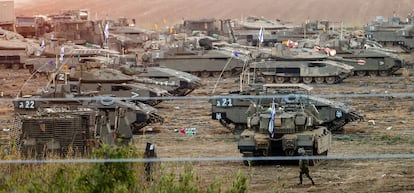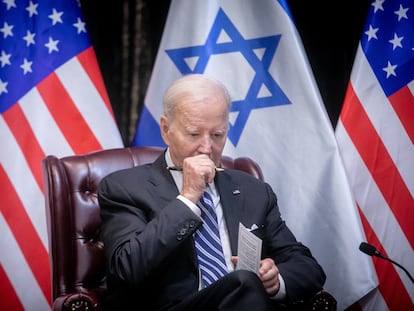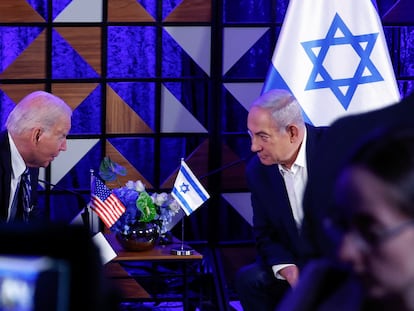On the brink of the abyss: The balance of forces in the face of Israel-Hamas escalation
Hamas’s urban guerrilla tactics, Hezbollah’s vast arsenal and Iran’s shadow backing challenge Israel’s military superiority in the region

The spiral of war unleashed by the barbaric Hamas attack against Israel on October 7 is for the moment confined to a conflict between the Israeli state and militia groups in the Gaza Strip. But the nature of the conflict and the response of Benjamin Netanyahu’s government, which has provoked a wave of indignation over measures such as cutting off Gaza’s supply of water, food, medicine and electricity — incompatible with the principles of international humanitarian law — are fueling a fire that is in serious danger of spreading. “The whole region is on the brink of falling into the abyss,” warned Jordan’s King Abdullah on Tuesday, ahead of the explosion that hit a hospital in Gaza causing hundreds of deaths and further inflaming tension.
The possible avenues for regional escalation are clear. The main one is the entry into the conflict of Hezbollah, a Lebanese party-militia with far greater military strength than Hamas and with close ties to Iran. The link between southern Lebanon and Tehran encompasses other points of risk such as the militias present in Syria and Iraq, which include members of Hezbollah itself, the Iranian Revolutionary Guard, and extremist groups with recruits from Afghanistan or Pakistan.
Other consequences are, of course, the outbreak of violent protests in the West Bank, with the possible destabilization of the Palestinian National Authority, as well as a renewed momentum of terrorist actions. For the nations of the Arab world, which have long been moving towards a normalization of relations with Israel, the risk is not military, but the boiling over of citizen anger that may be part of the calculations of other actors.
The following is a brief assessment of the military capabilities of four key players in this context: the two protagonists of the conflict — Hamas and Israel — the most likely path of expansion — Hezbollah — and its primary supporter Iran, emboldened by an increasingly explicit axis of confrontation with the West, with Russia in the lead and China in the rearguard.
Israel
Israel is the overwhelming military power in the Gaza conflict, with a clear advantage over its adversaries in terms of capabilities. Its annual defense spending is almost four times that of Iran, and is incomparable with the limited resources available to Hamas or Hezbollah.
Since its foundation, the State of Israel has had the firm backing of the United States, which supports it with military aid amounting to around $3.8 billion a year. Washington’s support has military derivatives of huge importance: an air force with high quality combat aircraft such as the F-35 and a world-leading anti-missile defense system known as the Iron Dome.
A history marked by conflict is also reflected not only in the enormous combat experience of the Israel Defense Forces (IDF), but also in a society with a considerable degree of training to take up arms and an enormous willingness to close ranks against Hamas.
The ultimate foundation of Israeli military superiority is, however, nuclear arms. Israeli authorities neither confirm nor deny that it is in their arsenal, but analysts agree that it is. The Stockholm International Peace Research Institute estimates that Israel has around 90 nuclear warheads.
All this does not mean that Israel does not have its limitations, or that it does not face very serious risks in the current conflict. The Hamas attack, as was the case with the Yom Kippur War in 1973, caught Israel completely by surprise, demonstrating failures in its intelligence-gathering capabilities. The prospect of having to manage two fronts at once — Hamas in Gaza and Hezbollah in Lebanon — represents a major challenge, all the more so if accompanied by an outbreak of violence in the West Bank and eventual skirmishes from Syria.
Hamas
The militia group has limited capabilities but combined with a willingness to act in violation of the basic rules of the laws of war, they are sufficient to inflict serious damage on Israel in offensive actions and certainly also in a defensive operation in the event of an invasion.
The attack on October 7 demonstrated Hamas’s ability to evade Israel’s surveillance and meticulously prepare a large-scale offensive without being detected, or quickly repelled. Experts also point to the considerable defensive capability Hamas will have if Israel decides to invade the Strip. The IDF has good quality main battle tanks — some 400 domestically produced Merkava IVs — but urban fighting always offers advantages to the defenders, especially in a territory as dense as Gaza, where Hamas has been preparing constantly over time for such a prospect, with vast tunnel networks and other logistical preparations. With anti-tank weapons at their disposal and with adequate positioning at strategic points, the militia’s potential should not be underestimated.
Naturally, everything concerning Hamas’s means is shrouded in mystery and there is no precise data. According to estimates by the International Institute for Strategic Studies published in 2022, Hamas had some 15,000 to 20,000 militiamen grouped in the Izz ad-Din al-Qassam Brigades. Before the current hostilities, it had a large arsenal of low-grade rockets. Now it is difficult to say how many it may have left after a dozen days of attacks on Israel.
Other groups also operate in the Strip, such as Islamic Jihad, accused by Israel of firing the rocket that hit the al-Ahli hospital on Tuesday, while the Gazan authorities accuse the Jewish State. In any case, even with the addition of other militia groups, Hamas’s military strength is meager.
Hezbollah
The Lebanese Shiite militia is sometimes defined as Hamas’s big brother: it has more men, a better arsenal and great strategic depth thanks to the corridor of Lebanon, Syria, Iraq and Iran.
Its main asset lies in its missile arsenal. Like Hamas, there is no transparency or verified data on its extent. According to Alma, an Israeli research center, Hezbollah has a few hundred high-precision missiles, some 5,000 missiles with a range of more than 200 kilometers (125 miles), with the Fateh-110 capable of reaching some 300 kilometers (187 miles), around 65,000 projectiles including rockets with a range of up to 45 kilometers (28 miles) and shorter-range missiles, in addition to 2,000 drones. There are other estimates of Hezbollah’s arsenal, some of which raise its available missile count to 150,000.
Even if that is not the case, Hezbollah’s capability is large enough to represent a serious threat. During the 2006 war, which lasted 34 days, Hezbollah fired some 4,000 rockets at Israel, from a pre-hostility arsenal of some 15,000, according to Israeli estimates. It is better prepared now than it was then.
In terms of members, estimates range from the 25,000 militiamen cited by the specialized magazine Janes in 2017 to the 100,000 declared by Hezbollah chief Hassan Nasrallah himself in 2021, a figure experts consider to be exaggerated. Hezbollah’s intense participation in the Syrian war on the side of Bashar al-Assad has led to huge casualties in recent years, but it has also allowed the militia to develop combat experience that is always a valuable element for any armed group.
Iran
Israel’s great adversary in the shadows. After the peace agreements with Egypt in 1979 and Jordan in 1994, and the ongoing process of normalization of relations with other Arab countries, Tehran represents the main challenge to the State of Israel. Although a direct confrontation is much less likely than the involvement of Hezbollah or militias present in Syria, Iran must be taken into account as a supporter of these groups and as a strategic reference.
The Iranian Armed Forces have significant assets. Its missile program has developed considerably, and it has long-range devices capable of striking Israel. In addition, it has developed an effective drone industry, capable of producing enough to divert some of its production to other countries, such as Russia, and effective enough to hit Saudi oil facilities a few years ago.
Its air force, though, is clearly inferior to Israel’s, with a largely obsolete fighter fleet consisting of Russian MiG or Sukhoi models of limited quality.
Although it has not been involved in an all-out conflict since the Iran-Iraq War (1980-1988), its Revolutionary Guard has experience through regional projection, contacts and action in other conflicts. This experience, its productive capacity, its experience in the clandestine supply of materials and in strategic advice or training, is the key element of Iran’s involvement in the absence of a direct confrontation.
The background element is, of course, the nuclear perspective. The collapse of the nuclear pact from which the Donald Trump administration withdrew has led to an acceleration of uranium enrichment activities and a softening of international controls. It is well-known that Iran has the capacity to reach the level of enrichment needed to arm a bomb and to produce the necessary amount quickly. On the other hand, its operational capacity to manufacture such a projectile is unknown and remains a subject on which experts disagree.
Sign up for our weekly newsletter to get more English-language news coverage from EL PAÍS USA Edition
Tu suscripción se está usando en otro dispositivo
¿Quieres añadir otro usuario a tu suscripción?
Si continúas leyendo en este dispositivo, no se podrá leer en el otro.
FlechaTu suscripción se está usando en otro dispositivo y solo puedes acceder a EL PAÍS desde un dispositivo a la vez.
Si quieres compartir tu cuenta, cambia tu suscripción a la modalidad Premium, así podrás añadir otro usuario. Cada uno accederá con su propia cuenta de email, lo que os permitirá personalizar vuestra experiencia en EL PAÍS.
¿Tienes una suscripción de empresa? Accede aquí para contratar más cuentas.
En el caso de no saber quién está usando tu cuenta, te recomendamos cambiar tu contraseña aquí.
Si decides continuar compartiendo tu cuenta, este mensaje se mostrará en tu dispositivo y en el de la otra persona que está usando tu cuenta de forma indefinida, afectando a tu experiencia de lectura. Puedes consultar aquí los términos y condiciones de la suscripción digital.
More information
Archived In
Últimas noticias
Welcome to the post-religion era: The idea of Christianity as the absolute truth has become obsolete
‘I thought you would like it’: The risky sexual practice popularized by TV shows and TikTok
The digitalization of tourism: ‘They promise experiences and gave us the worst possible one’
Mexican peso defies uncertainty with forecasts of a new period of stability in 2026
Most viewed
- Sinaloa Cartel war is taking its toll on Los Chapitos
- Reinhard Genzel, Nobel laureate in physics: ‘One-minute videos will never give you the truth’
- Oona Chaplin: ‘I told James Cameron that I was living in a treehouse and starting a permaculture project with a friend’
- Why the price of coffee has skyrocketed: from Brazilian plantations to specialty coffee houses
- Silver prices are going crazy: This is what’s fueling the rally










































